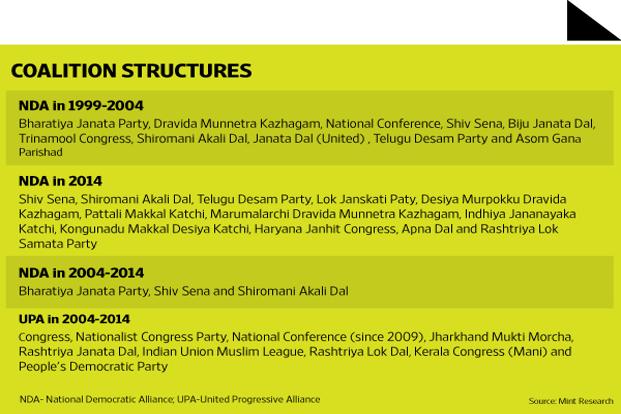A government formed by a number of political parties instead
of just one political party is called a ‘coalition government’.
The party that has secured the largest number of seats in
the Lok Sabha (House of People), after the elections, forms the new government.
In a complex socio-political environment, peoples choices
and affiliations vary and thus votes get distributed among a number of
political parties. In such cases the leading party allies with other parties
that have also won a sizable number of seats, thereby securing a majority of
seats in the Lok Sabha. Once the coalition alliance has numerical strength in
the Lok Sabha, it is invited by the President of India to form the Union
Government and the coalition’s selected nominee is made Prime Minister. The
Prime Minister is generally a prominent leader of the party with the largest
number of seats in the coalition.
There are two types of coalition alliances
1.
Pre-Poll Alliance – formed when political
parties declare their support to a coalition even before the election has taken
place
2.
Post-Poll Alliance – formed after the election
when political parties, alarmed by their few political gains, come together to
form the government
Governance reformers have suggested that the Election
Commission of India should ban post poll alliances and make it mandatory for
political parties to declare their affiliations through pre-poll alliances so
that voters can make informed choices at the polls.
ADDITIONAL INFORMATION
A coalition government is a cabinet of a parliamentary government in which several political parties cooperate, reducing the dominance of any one party within that coalition. The usual reason given for this arrangement is that no party on its own can achieve a majority in the parliament. However, a coalition government may also be shaped in time of a national complexity or crisis. If a coalition collapses, a confidence vote is assumed or a motion of no confidence is passed.
India’s first ever
coalition government was formed under the Prime Ministership of Morarji Desai.
It existed from 24th March 1977 to 15 July 1979 and was headed by the
Janata Party.
The first successful
coalition government in India to complete the whole tern of five years was the
BJP led National Democratic Alliance with Atal Bihari Vajpayee as Prime
Minister from 1999-2004.
Another coalition, the UPA
headed by the Congress, consisting of 13 separate parties ruled India for two
terms from 2004 – 2014.
LEVELS OF COALITION
Coalition can take place
at one of the three levels
1. Electoral:
This coalition occurs when two or more parties contest elections together to fight against a common enemy. This may
range from electoral alliance between parties at the National level to a mere
understanding at the constituency level.
2.
Parliamentary- This coalition occurs when no single party gains
a majority and the party asked the party asked to form the Government refers to
rule as a minority Government on an agreement on an understanding with another
external support.
3. Governmental- The
Governmental coalition is a 'power sharing' coalition and it occurs when two or
more parties, none of which is able to win a majority of its own, combine to
form a majority Government.
MERITS OF COALITION GOVERNMENT
- - Coalition does not offer one party with the authority to put into practice their ideas.
- - A coalition government is a partnership between parties and both parties will be treated equal.
- - More minds are involved in decision making in a coalition government
DEMERITS OF COALITION GOVERNMENT
- - Coalition parties produce unsteadiness within the coalition government
- - It is difficult to attain true harmony among different political parties
- - Each political party has the difficulty of intra conflicts. It is not easy to keep all the displeased party members happy.
